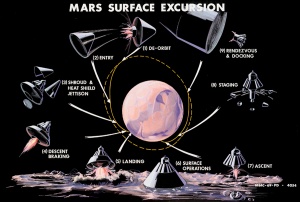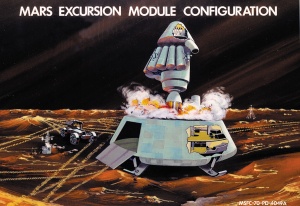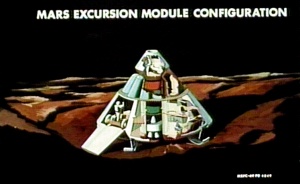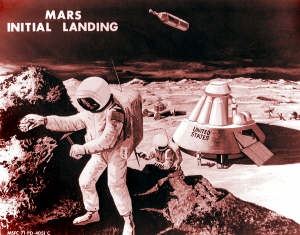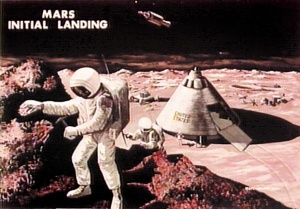Manned Mars Landing by Wernher von Braun Pt 3
From The Space Library
Contents |
MARS SURFACE EXCURSION
The three man landing party from each ship is carried from the orbiting spacecraft to the surface in the Mars Excursion Module (MEM). Except for the effects of the Martian atmosphere, the landing and return to orbit sequence is analogous to the Apollo lunar landing operation utilizing the Lunar Module. In the case of Apollo 11, the Mars orbit spacecraft is analogous to Columbia and the MEM is analogous to Eagle.
Following final checkout, the MEM is separated from the spacecraft and de orbited (1) by the retro firing of a small rocket motor. The MEM is then aerodynamically ¬decelerated (2) as it falls toward the surface. As the MEM approaches the surface, the protective shroud and a portion of the heat shield are jettisoned (3). Jettisoning of the shroud allows use of the ascent stage as an abort vehicle, if required before landing. The descent stage engine then provides terminal braking (4) and hovering just prior to touchdown (5). The MEM then spends 30 to 60 days on the surface of Mars (6).
Mars Surface Excursion
At the conclusion of surface operations, the ascent stage is fired (7) to initiate the return to Mars orbit and the waiting spacecraft. Propellant tanks are staged (discarded) during ascent to effect weight saving (8). After achieving proper orbit conditions, the MEM will rendezvous and dock with the spacecraft (9). Following docking, the crew will transfer to the Mission Module, and the MEM will be discarded.
MARS EXCURSION MODULE CONFIGURATION
The Apollo shaped Mars Excursion Module (MEM) is designed to carry three men to the surface of Mars and return the crew, scientific data, and samples to the spaceship. It provides living quarters and a laboratory during the 30 60 day stay on the Mars surface. The MEM consists of descent and ascent stages. The ascent stage houses the three man crew during entry, descent, landing, and ascent. The ascent stage consists of the control center, ascent engine and propellant tanks. The descent stage contains the crew living quarters and laboratory for use while on Mars, the descent engine and propellant tanks, landing gear and an outer heat shield for the aerodynamic entry phase of the descent. A small one man rover vehicle is provided in the descent stage for surface mobility. All descent stage equipment is left on the Martian sur¬face. The capability is provided for one man to land a MEM and bring a stranded crew back to the ship orbiting Mars.
Mars Excursion Module Configuration (1970)
Mars Excursion Module Configuration (1969)
The diameter of the MEM at its base is 30 feet. At departure from the spacecraft, the MEM weighs about 95,000 pounds.
MARS SURFACE ACTIVITY
Man's first step on Mars will be no less exciting than Neil Armstrong's first step on the moon. The Mars surface activity on the first mission will be similar in many ways to the Apollo 11 moon surface activity. Notable, however, is the much longer stay time (30 60 days per MEM), thus allowing more extensive observations, experimentation and execution of mission scientific objectives. The small rover vehicle allows trips to interesting surface features beyond the immediate landing area. Surface operations include experiments to be performed in the MEM laboratory as well as the external operations on Mars' surface.
During the planetary surface operations, the men in the orbiting spacecraft continue their experimentation observations, monitor the surface operations, and maintain the necessary spacecraft operations.
Mars Initial Landing (1970)
Mars Initial Landing (1969)
SCIENTIFIC OBJECTIVES MANNED MARS LANDING MISSION
Geological and geophysical investigations of Mars are significant because Mars probably closely paralleled the earth in origin and the development. Basically the data required about Mars are: (1) its physical, mineralogical, and chemical composition, (2) distribution of surface material and the processes by which features and material were formed, altered, transported, and distorted, (3) the record of any life there, and (4) any major events preserved in Martian rocks. These investigations require the presence of a skilled observer functioning as an interpretative scientist..
Perhaps the single, most consuming scientific question of the space program is: "Does extraterrestrial life exist in our solar system?" Has life ever existed on Mars? Does it exist now? Are conditions such that some form of life could exist? Preliminary data indicate that some lower forms of life can survive in the Martian environment, and conceivably in isolated areas higher forms of life may exist. Man on Mars will be able to study not only the forms of life indigenous to Mars, but also the behavior of terrestrial life forms transplanted to the Martian environment.
Drilling for or locating water will be an early objective on Mars, and its discovery would open many possibilities for utilization of Mars. For example, it might become possible to produce rocket fuel for the return trip on later missions.
- MAKE GEOPHYSICAL OBSERVATIONS
- COLLECT SOIL AND ATMOSPHERIC SAMPLES
- STUDY LIFE FORMS
- STUDY BEHAVIOR OF TERRESTRIAL LIFE FORMS IN MARS ENVIRONMENT
- SEARCH FOR WATER AND USABLE NATURAL RESOURCES
